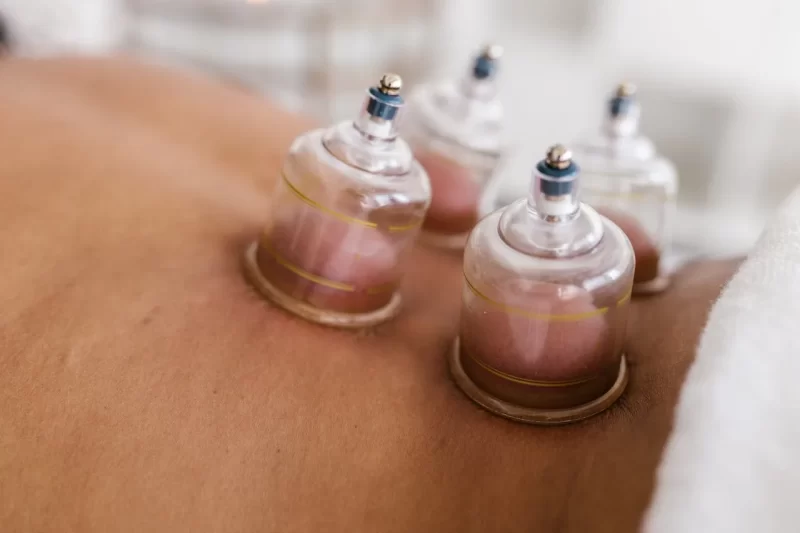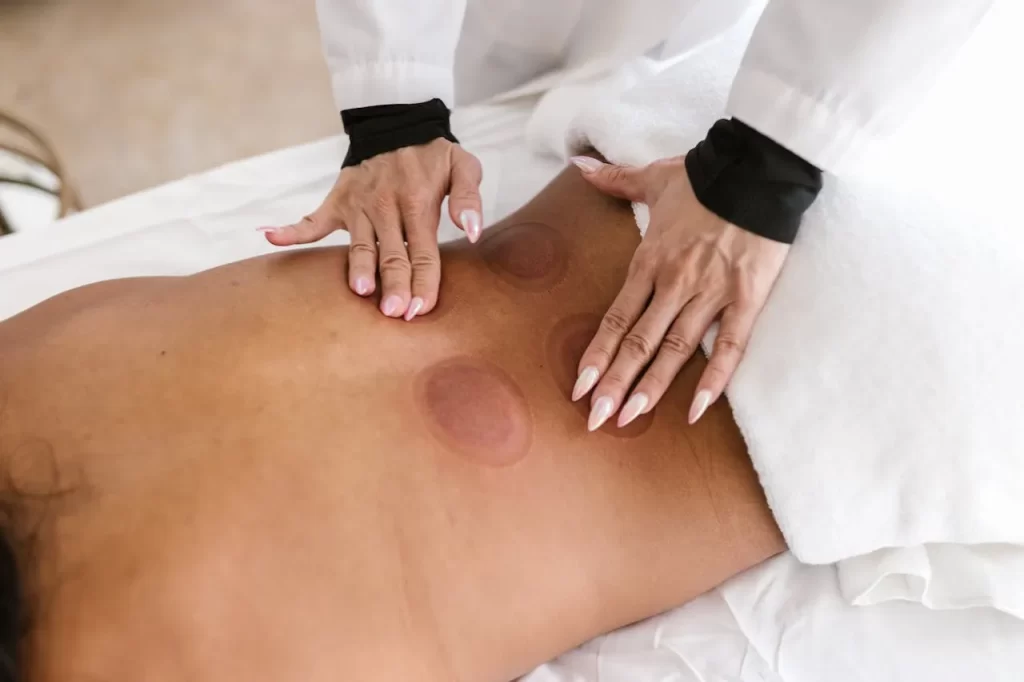Why Cupping Therapy/Hijama? A Deep Dive into Its Physiotherapeutic Benefits


In recent years, the resurgence of ancient healing practices has garnered significant attention in healthcare. One such time-honored technique making a notable comeback is cupping therapy, also known as hijama. Rooted in the traditional medicine of various cultures, this therapeutic approach involves placing cups on the skin to create a suction effect. Physiotherapists worldwide, including those at WHPT Pakistan, are increasingly incorporating cupping therapy into their treatment methodologies to provide enhanced healing and holistic care.
With origins dating back thousands of years, cupping therapy has been a cornerstone of traditional Chinese, Egyptian, and Middle Eastern medicine. The essence of this therapy lies in strategically placing cups on specific points of the body and creating suction, either through heat or a mechanical pump. The resulting suction draws the skin and underlying tissue into the cup, fostering increased blood flow and stimulating the body’s natural healing processes.
Diverse variations of cupping therapy cater to different therapeutic needs. The primary types include:
This method involves creating suction using heat or a suction pump without making any incisions on the skin. The cups are placed strategically to promote blood circulation and alleviate muscle tension.
In wet cupping, a small incision is made on the skin before applying the cups, allowing a controlled amount of blood to be drawn out. This variant is believed to facilitate detoxification and is often used in conjunction with physiotherapy.
Cups are moved around the skin to create a massage-like effect, promoting blood circulation and alleviating muscle tension. This dynamic form of cupping is particularly effective for enhancing flexibility and reducing muscle spasms.
In this variant, cups are applied and removed quickly to stimulate the skin without needing an extended session. Flash cupping is often employed for stimulating and revitalizing skin effects.

At WHPT Pakistan, physiotherapists recognize the multifaceted benefits of cupping therapy and seamlessly integrate it into their treatment plans. This integration is particularly relevant for patients dealing with musculoskeletal issues, chronic pain, and those on the path to recovery from injuries.
Cupping therapy is renowned for its efficacy in alleviating pain. Promoting blood flow and reducing inflammation proves beneficial for conditions such as chronic back pain, arthritis, and muscle injuries. Physiotherapists at WHPT Pakistan often leverage cupping therapy to enhance the overall effectiveness of pain management strategies.
The suction created by cupping therapy aids in releasing tension in the muscles, promoting relaxation and improving flexibility. This is particularly useful for patients with muscle spasms or tightness or those in the process of recovering from injuries.
Cupping therapy enhances blood circulation, ensuring the efficient delivery of oxygen and nutrients to the affected areas. Improved circulation accelerates the body’s natural healing processes, aiding recovery from injuries and reducing overall healing time.
Wet cupping, commonly known as hijama, is believed to facilitate the removal of toxins from the body through the controlled removal of a small amount of blood. This detoxification process complements physiotherapy, contributing to improved overall health.
Cupping therapy can assist in breaking down scar tissue, promoting more effective healing after surgeries or injuries. Physiotherapists at WHPT Pakistan utilize this technique to enhance the range of motion and reduce stiffness associated with scar tissue formation.
If you’re intrigued by the potential benefits of cupping therapy and are searching for a clinic near you, consider exploring phrases like “cupping therapy near me” or “hijama near me.” WHPT Pakistan emerged as a prominent physiotherapy clinic that offers cupping therapy as an integral component of its comprehensive approach to patient care.
Conveniently located in Bahria Town Lahore, WHPT Pakistan is a state-of-the-art physiotherapy clinic dedicated to prioritizing patient well-being and fostering a holistic approach to recovery. The clinic’s team of experienced physiotherapists seamlessly integrates cupping therapy into personalized treatment plans, ensuring that each patient receives the best care possible.
The WHPT Pakistan physiotherapists boast extensive experience incorporating cupping therapy into their treatment strategies. They undergo continuous training to stay abreast of the latest techniques and research in the field, ensuring the highest standards of care.
At WHPT Pakistan, the philosophy revolves around a holistic approach to healing. Cupping therapy is seamlessly integrated into physiotherapy treatments to address the root causes of pain and discomfort, providing patients with a more comprehensive and effective recovery experience.
WHPT Pakistan prioritizes individualized care, taking the time to understand each patient’s unique needs. Treatment plans, which may include cupping therapy, are tailored to ensure the best possible outcomes for every individual.
The clinic is equipped with modern facilities to provide a comfortable and safe environment for the healing journey. Whether seeking relief from chronic pain or recovering from an injury, WHPT Pakistan ensures patients have access to the resources needed for a successful recovery.
When performed by qualified practitioners, Cupping therapy can be a safe and effective way to promote healing. Here’s a step-by-step guide to understanding how cupping therapy is typically conducted:
Before the actual cupping session, a thorough consultation is conducted. This involves discussing the patient’s medical history, current health conditions, and the specific reasons for seeking cupping therapy.
The practitioner examines the patient’s skin and identifies suitable points for cup placement based on the individual’s needs. Areas with muscle tension, pain, or energy stagnation are often targeted.
Cups come in various materials, including glass, silicone, or plastic. The practitioner selects the appropriate cup size and material based on the treatment goals and the patient’s skin type.
Cups are applied to the chosen areas of the body. In the case of dry cupping, suction is created using a pump or heat. For wet cupping (hijama), a small incision is made before applying the cups.
The cups are left in place for a specified duration, typically ranging from 5 to 15 minutes. Depending on the treatment plan, the practitioner may move the cups around (massage cupping) or keep them stationary.
After the designated time, the cups are carefully removed. For wet cupping, the practitioner may perform additional steps, such as making small incisions to facilitate the controlled removal of a small amount of blood.
The patient is provided with aftercare instructions, including staying hydrated, avoiding strenuous activities, and protecting the cupped areas from extreme temperatures.
While cupping therapy, especially wet cupping or hijama, can offer various health benefits, seeking treatment from qualified and trained practitioners is crucial. Hazards associated with getting hijama from unqualified individuals include:
Improper sterilization techniques or unclean tools may lead to the risk of infection, threatening the patient’s health.
Unqualified practitioners may need more expertise to control bleeding during wet cupping, leading to excessive blood loss and potential complications.
Improper cupping techniques can result in excessive bruising and scarring, affecting the aesthetic appearance of the skin.
Unqualified practitioners may need more medical knowledge to diagnose underlying health conditions accurately, potentially delaying proper treatment.
To ensure a safe and effective cupping therapy experience, it is essential to consider the following precautions and care measures:
Seek cupping therapy, especially hijama, from certified and experienced practitioners who adhere to proper hygiene and safety protocols.
Before undergoing cupping therapy, consult with a healthcare professional, especially if you have pre-existing medical conditions or are taking medications.
Ensure that all equipment used in cupping therapy is properly sterilized to minimize the risk of infection.
Share relevant medical information with your cupping therapist, including any ongoing treatments or health concerns.
Sunnah cupping refers to the practice of cupping therapy based on the teachings of the Prophet Muhammad (peace be upon him). In Islamic tradition, cupping therapy, known as hijama, is considered a therapeutic practice and a form of preventive medicine. Sunnah cupping is often performed on specific dates in the Islamic calendar, such as the 17th, 19th, and 21st days of the lunar month.
Cupping therapy may leave temporary marks on the skin, typically in the form of circular bruises. However, these marks usually fade within a few days to a couple of weeks and are not permanent.
While cupping therapy is generally safe, individuals with certain medical conditions, such as hemophilia or skin conditions, may need to avoid or modify cupping treatments. It is crucial to consult with a healthcare professional before undergoing cupping therapy.
In Islamic tradition, hijama (cupping therapy) has both therapeutic and spiritual significance. It is considered a Sunnah (practice of Prophet Muhammad) and is believed to have physical and spiritual benefits. Many individuals seek hijama for its holistic healing properties and its alignment with Islamic teachings.
Cupping therapy is generally not painful. Patients may feel a sensation of tightness or suction, but it is not typically described as painful. The intensity varies based on the individual’s tolerance and the type of cupping being performed.
The frequency of cupping therapy depends on the individual’s health needs and the nature of their condition. Based on the practitioner’s recommendation, it is common for sessions to be scheduled weekly, bi-weekly, or monthly.
In conclusion, cupping therapy, including the traditional practice of hijama, has seamlessly found its place in mainstream physiotherapy as a valuable tool for promoting holistic healing and overall well-being. Physiotherapists at WHPT Pakistan harness the power of this ancient technique to enhance their treatment protocols, providing patients with a comprehensive and effective approach to recovery.
As individuals explore the potential benefits of cupping therapy, WHPT Pakistan emerges as a beacon of expert care and a commitment to overall health. Whether you’re grappling with chronic pain, recovering from an injury, or simply seeking a holistic approach to well-being, consider the integrated care provided by WHPT Pakistan, where cupping therapy is not just a tradition but a dynamic and influential element in the modern physiotherapeutic landscape. Your journey to optimal health begins at WHPT Pakistan, where ancient wisdom meets contemporary care.